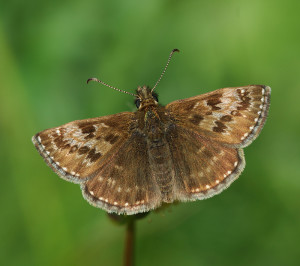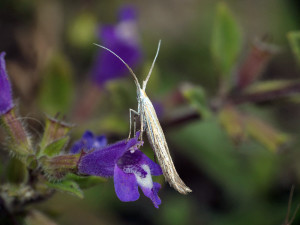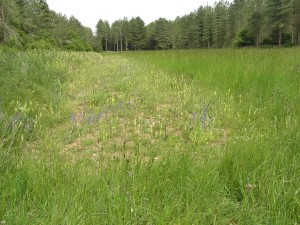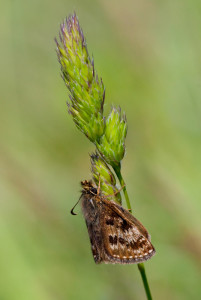
Dingy Skipper
Greenwings are proud to be corporate supporters to Butterfly Conservation and regularly contribute towards their superb efforts to protect butterflies, moths and their habitats. We were delighted to hand over a cheque for £1,500 this year, to assist with the East of England Regional Officers project for implementing and leading a programme of heathland habitat restoration at a landscape-scale on fifteen ecologically linked Norfolk Brecks sites. You can read more about the background to the project below, along with a brief update on it at the bottom of the page.
We would like to thank our guests who joined our butterfly & moth watching holidays this year, whose support has made this donation to Butterfly Conservation possible.
Project Background
Bare in the Brecks
by Sharon Hearle, Senior Regional Officer, East of England
The Norfolk Brecks, in the heart of Eastern England, are a distinctive landscape area with a particularly dry climate and light sandy soils. Sandstorms were once a regular event, most memorably one which almost engulfed the Suffolk village of Santon Downham in the seventeenth century. The area was historically characterised by huge tracts of open heathland which have been reduced in recent times by large scale forestry and intensive agriculture. Thetford Forest was planted by the Forestry Commission (FC) in the 1930s on open heathland or farmland and specialist moths and butterflies have clung on in the remaining glades, rides and open heathland between the main forest blocks. The Brecks support many rare and threatened species which depend on early successional habitat (weed patches on bare ground) including Grizzled Skipper, Dingy Skipper and Grayling butterflies and Lunar Yellow Underwing, Forester, Marbled Clover and Tawny Wave moths. The Grey Carpet and Basil Thyme Case-bearer moths are only knownto occur in the UK in the Brecks.

Basil Thyme Case-bearer moth
Thanks to a grant from the Wren Biodiversity Action Fund, Butterfly Conservation (BC) established a landscape-scale project in the Norfolk Breck landscape between 2010 and 2012. The project was able to fund a variety of bare ground management techniques on 15 sites across the landscape. The project used four main methods of creating bare ground: rotovating (breaking up the soil), turf stripping, scrub clearance and deep ploughing to create 57 plots. BC consulted with Norfolk Archaeology to make sure archaeological sites were avoided. The size of the plots varied from a few square metres to much larger plots measuring several hectares. Species responses were monitored over the three-year period by looking for adults, caterpillars and their foodplants. This work is still ongoing as the plots develop, particularly the turf stripped and deep plough plots.
Dingy Skipper responded well to the development of bare ground plots, appearing on over half of the turf stripped areas created. At one site – Coldharbour Wood, a 300 metre-long bare ground plot was created in 2011 using an excavator which heaped the scraped material into a south facing bank. The turf stripped plot contrasted well with the permanent grassland along this long, wide forest ride. Dingy Skipper had not been reported at this site before despite searches but was known to be present about two miles away. Bird’s-foot-trefoil quickly appeared on the plot and carpeted the bare ground providing ideal egg laying conditions for the butterfly. Dingy Skippers appeared in 2014 when five were seen and it is hoped that a colony will survive for many years to come on this plot until new disturbance takes place.

Bare ground plot with Dingy Skipper
The species present on these weedy patches of bare ground change annually and are dependent on site management such as grazing. Plots sometimes only remain suitable for a given species for a short period of time until new disturbance takes place. The Grey Carpet and Basil Thyme Case-bearer moths and their larval foodplants both responded well to rotovation but soon disappeared as grass cover re-established. Almost all the different disturbance methods created an abundance of nectar throughout spring, summer and autumn which attracted butterflies and moths from the wider landscape including Forester and Marbled Clover moths. The Forester appeared on 27 plots attracted to the Viper’s Bugloss and other wild flowers, especially in the second season of the plot.
The Lunar Yellow Underwing moth is a scarce species with its national stronghold in the Brecks. This moth avoids long rank grassland and needs fine tussocky grasses and bare soil for its caterpillars which feed at night over the winter period. The moth has been found on 28 plots but in quite low numbers. As the sward develops it is hoped that Lunar Yellow Underwing will one day be numerous on the large deep plough plots which cover several hectares.
BC’s work has shown that the fortunes of threatened Breckland butterflies and moths can be reversed and the importance of disturbance management and bare ground is well established with land managers. Creating bare ground at a landscape scale increases the likelihood of species being able to move and colonise new habitat patches and there remains plenty of scope for further intervention across this large landscape.

Dingy Skipper
Latest news
The regional officer has continued to co-ordinate monitoring work and landowner liaison in the Brecks in 2016.
Dingy Skipper has responded particularly well to the creation of bare ground and there are now several new locations for the butterfly in Norfolk and Suffolk. The regional officer has organised several events to encourage volunteer recording and with an impressive appearance of the rare Basil Thyme Case-bearer at one site. Advice has been given to the BTO about bare ground creation and The Forestry Commission have started to re-rotovate some of the early bare ground plots created in 2012. Norfolk Wildlife Trust has created many new bare ground plots at Brandon Country Park and Cranwich Heath following Butterfly Conservations model.





